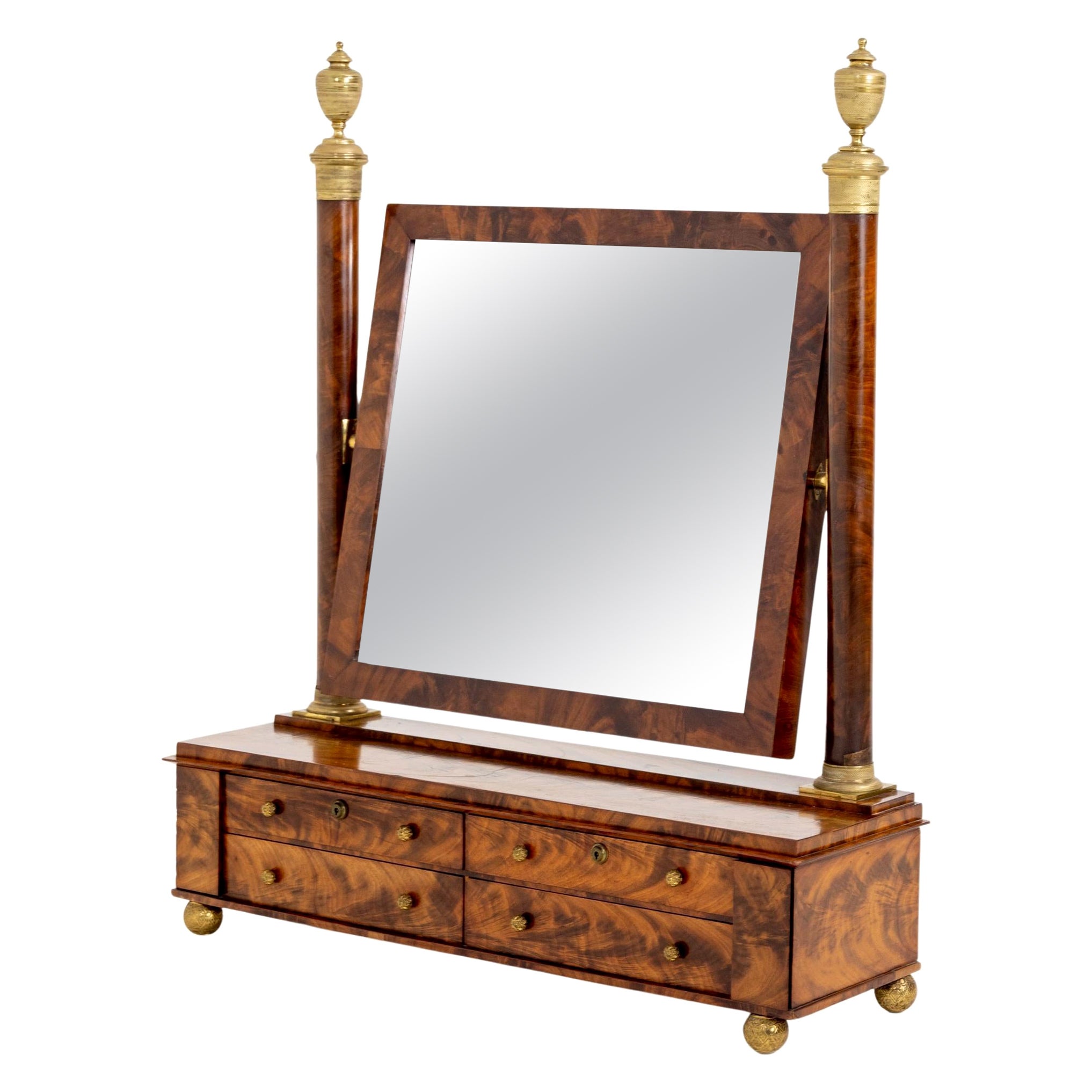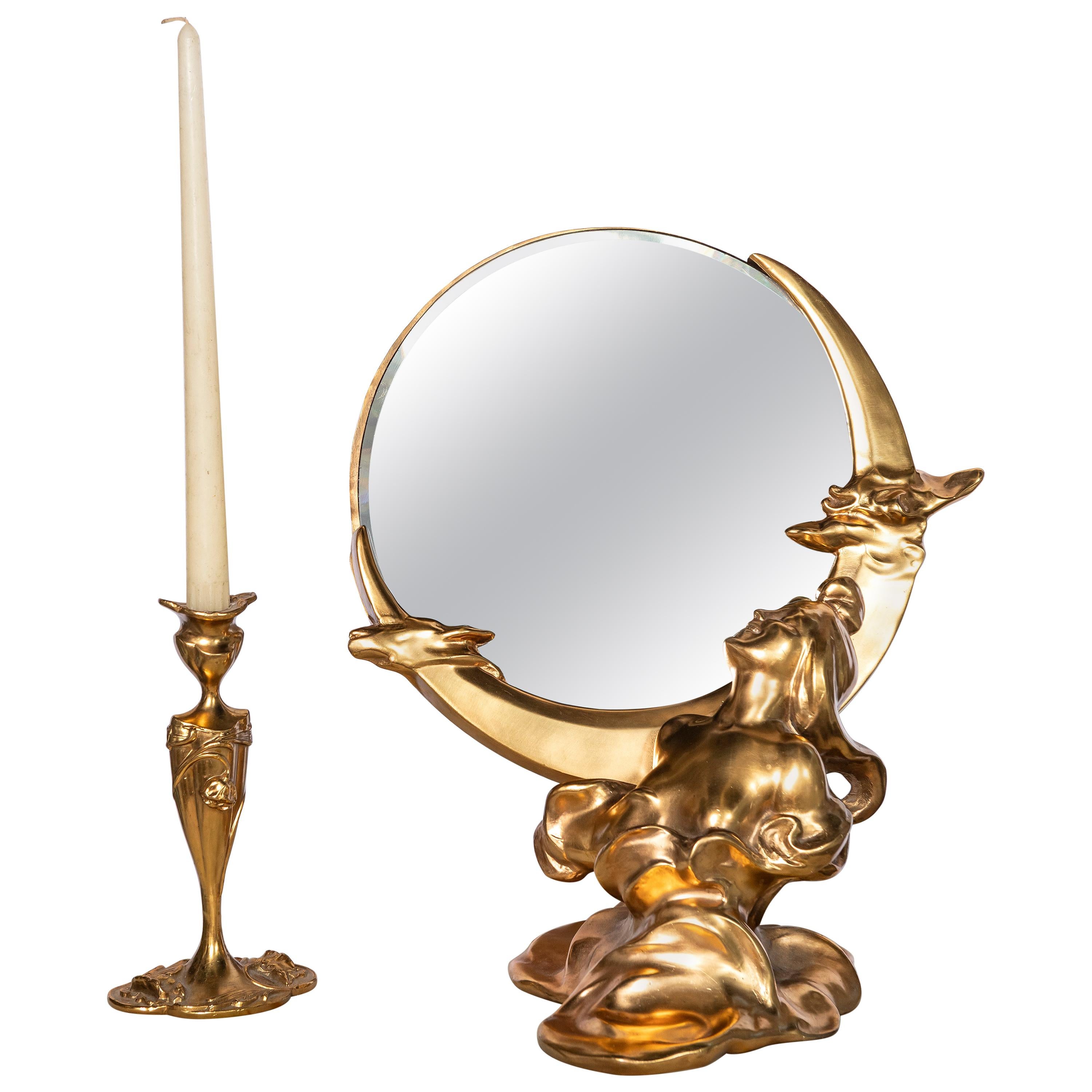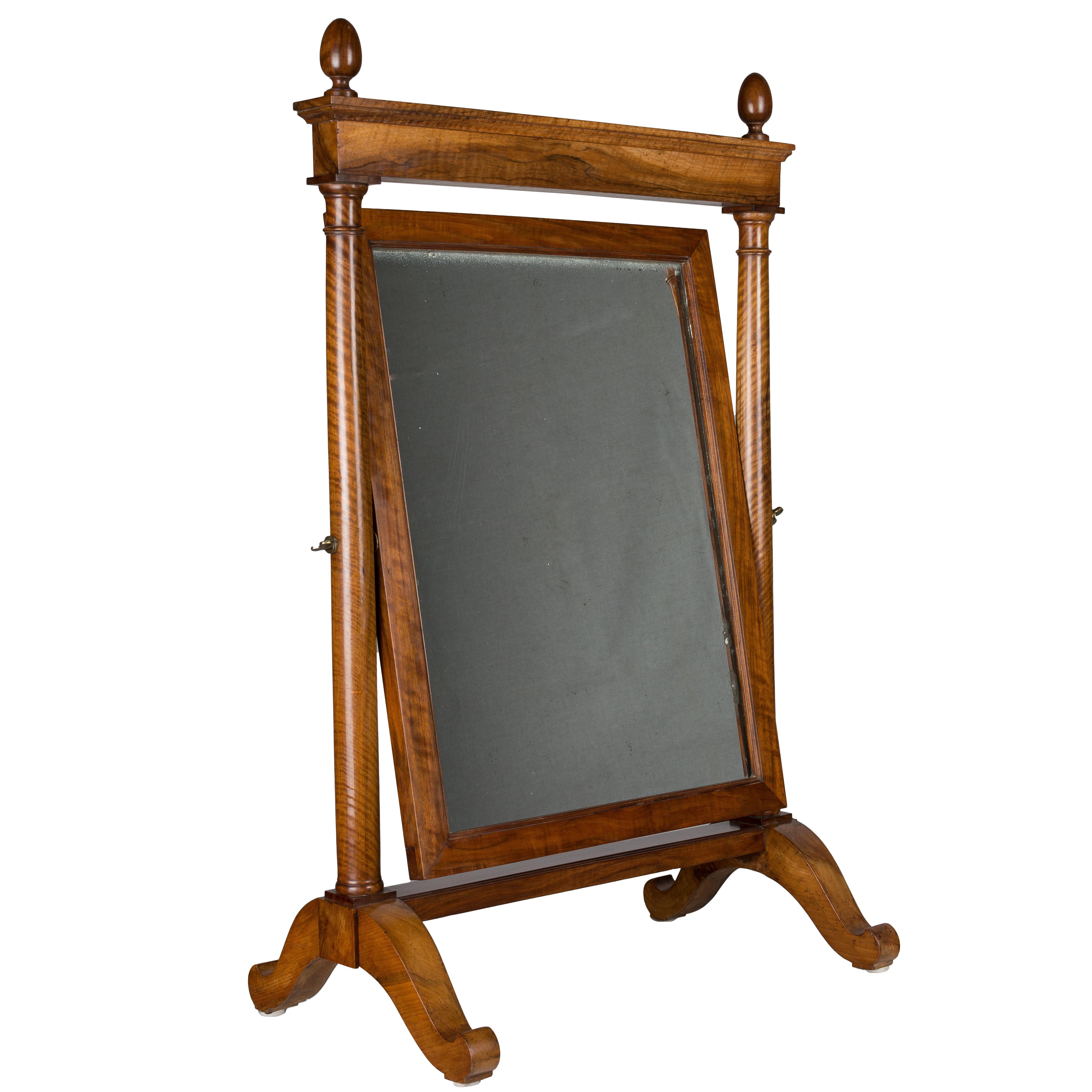Items Similar to French 19th Century Restauration Psyche Coiffeuse Mirror
Want more images or videos?
Request additional images or videos from the seller
1 of 13
French 19th Century Restauration Psyche Coiffeuse Mirror
About the Item
A French 19th Century Restauration Psyche Coiffeuse mirror
Patinated and gilt bronze rectangular Psyche Coiffeuse Mirror
designed with Greek frieze, palmettes, oves, strings of pearls, foliage scrolls and gadroons ormolu mounts
Restauration Period
Circa 1830.
The Restauration Style (1815-1830)
After Napoleon's defeat at Waterloo on 18 June 1815, power in France was taken over by the two brothers of Louis XVI: the Count of Provence, who reigned as Louis XVIII (1815-1823), then the Count of Artois, known as Charles X, who ruled until 1830, when he was overthrown by the July Revolution and replaced by a new king, Louis-Philippe I (1830-1848).
This period known as the Restauration (1815-1830) was primarily a reaction against the pomp and circumstance of the Empire. It imposed an elegance and refinement in furnishings and decoration that Napoleon's taste for grandeur and glamour had, in a way, obscured. But under the Restauration, it was no longer the orders of the royal family or those of rich aristocrats that set the tone. Fashion was now adapted to the needs and tastes of the new bourgeois society, which rented flats in Paris that were more or less plush and suited to fam-ily life.
The concept of comfort was influenced by a certain English art of living. Regency style furniture was imported from England, particularly chests of drawers. Mahogany, con-sidered too heavy, was replaced by blond woods. Imposing furniture, decorated with bronz-es, gave way to smaller, finely cut or inlaid pieces. As in the Regency period a century earli-er, the vast rooms of the official palaces were abandoned to rediscover the charm of the in-timacy of small salons and boudoirs.
But this change of style does not call into question certain essential elements of the decor, which remains deeply inspired by the previous period. Thus, the Restauration continued the neo-classical tradition cherished by Napoleon I and brought it to an unprecedented de-gree of refinement.
At the same time, Romanticism sought its inspiration in an imaginary Middle Ages that combined the classical ornamentation of the decor with the rosettes, festoons and ogives of the Gothic cathedrals that were in vogue under Charles X.
The ornamentation, light and very refined, underlines the structure of the furniture. The molding, abandoned under the Empire, reappears delicately on consoles, secretaries, tables and imposing furniture such as bookcases.
Some decorative motifs from the Empire stye remain, but in a simplified form. Among the most used are the palmette - rounder, smaller and stylized, the cornucopia, the lyre, the swan, the star, and the dolphins. More rarely, chimeras, griffins and sea horses are found. However, Restauration motifs differ from Empire motifs in the way they are treated, much lighter and less solemn than in the previous period.
Classic motifs include oves, strings of pearls, foliage scrolls, gadroons, garlands or bouquets of flowers, ribbons, and flower crowns.
In addition to the allegorical motifs and antique (Amours, Psyches, Adonis, columns, pilastres, straight cornices) inherited from the previous period, Gothic motifs invaded furniture and objects, and constituted the novelty of this period. Everyday objects, from the most modest to the most luxurious, known as “à la cathédrale” or "troubadour", such as vases, clocks, torches, inkwells, flasks, and chests, are covered with details inspired by fenestration, rosettes, buttresses, arcatures, festoons, lacework, and stone belfries. Under Charles X, the "Gothic" taste was the first reaction to the ubiquitous antique style defined by Percier and Fontaine in the early 19th Century.
- Dimensions:Height: 16.15 in (41 cm)Width: 7.09 in (18 cm)Depth: 4.34 in (11 cm)
- Style:Restauration (Of the Period)
- Materials and Techniques:
- Place of Origin:
- Period:
- Date of Manufacture:circa 1830
- Condition:Wear consistent with age and use.
- Seller Location:Saint-Ouen, FR
- Reference Number:1stDibs: LU2612331454902
About the Seller
4.9
Vetted Seller
These experienced sellers undergo a comprehensive evaluation by our team of in-house experts.
1stDibs seller since 2017
57 sales on 1stDibs
Typical response time: 1 hour
- ShippingRetrieving quote...Ships From: Saint-Ouen, France
- Return PolicyA return for this item may be initiated within 2 days of delivery.
More From This SellerView All
- French 19th Century Twelve Lights Restauration Period ChandelierLocated in Saint-Ouen, FRA twelve lights green patinated metal, bronze and ormolu restauration period chandelier.Category
Antique 1820s French Restauration Chandeliers and Pendants
MaterialsBronze
- 19th Century French Lacquered Wood ChandelierLocated in Saint-Ouen, FRA 19th century French polychromed lacquered wood eight-light chandelier Lacquered gloss cream wood with green, red and brown highlights Contained vase ending in foliated seed welcoming eight arms forming semicircles. The top has a frieze of red flowers in green interlacing and is topped with leaves and a painted egg cream...Category
Antique 1890s French Louis XVI Chandeliers and Pendants
MaterialsWood
- French 19th Century Pair of Porcelain Cache-PotsLocated in Saint-Ouen, FRPair of polychromed hand painted porcelain with Japonisme floral decoration Ormolu-mounted with open-worked base and rim Louis XVI Style circa 1880.Category
Antique 1870s French Chinoiserie Planters, Cachepots and Jardinières
MaterialsOrmolu
- A Very Fine Quality 19th Century French Pair of CandlesticksLocated in Saint-Ouen, FRVery Fine French 19th Century Pair of Candlesticks In ormolu, very finely chiseled and decorated with knotted garlands, branches of leafy flowers, spokes of hearts, leaves of water...Category
Antique 1870s French Louis XVI Candlesticks
MaterialsOrmolu
- A French 19th Century Pair of Louis XIV Style StoolsLocated in Saint-Ouen, FRA French 19th Century Pair of Large Rectangular Stools natural and carved wood. The 4 sheaths feet carved and linked by a stretcher. Louis XIV Style Napoléon III Period Circa 1880 Used Petit Point Tapestry Upholstery If the stool played a great role at the court of Louis XIV, it was also the pretext of a war... that of the stools precisely, recounted by Saint-Simon. The Duchesses fought and the Duchesse became a seat with very curious forms. There were benches and chairs, then armchairs, not to mention stools. A seat dear to the duchesses. Some fought for one, to sit in the presence of the queen. Standing, while others, sometimes cousins, were seated, was intolerable. The Duke of Saint-Simon was pleased to recount the «war of stools». This one was provoked by Mme de Chevreuse who sat, without any way, before Queen Anne of Austria...Category
Antique 1880s French Louis XIV Stools
MaterialsBeech
- 19th Century French Secretaire Flap "Billet Doux", Also Called "Portfolio"Located in Saint-Ouen, FRSecretaire flap "Billet douce", also called "portfolio" Veneer of Amboyna burl, rosewood and blackened sticks, resting on two pilasters carried by two fluted pads connected by a turned and fluted spacer. It opens with a flap, Interior in lemontree presenting, in addition to a tablet sheathed in leather, mail lockers and a pen tray with its original glass tank...Category
Antique 1830s French Louis Philippe Desks and Writing Tables
MaterialsWood
You May Also Like
- 19th Century Biedermeier Cherry Psyche / Table MirrorLocated in Darmstadt, DEBeautiful Biedermeier psyche / table mirror from around 1830. The psyche is made of cherrywood (solid and veneer). The mirror is rotatable and there is a drawer in the base. In very ...Category
Antique Mid-19th Century German Biedermeier Table Mirrors
MaterialsCherry
- Table Mirror, France Early 19th CenturyLocated in Greding, DETable mirror in mahogany on oak with brass urn-shaped pinnacles and four drawers.Category
Antique 19th Century French Empire Table Mirrors
MaterialsBrass
- Gilt Bronze Mirror and Candlestick, France, 19th CenturyLocated in Buenos Aires, Buenos AiresGilt bronze mirror and candlestick. France, 19th century. Dimensions mirror: 39 cm height. 26 cm depth. 20 cm width. Dimensions candlestick: 20 cm height. 8 cm depth. 11 cm width.Category
Antique 1890s French Art Nouveau Candlesticks
MaterialsBronze
- Late 19th Century French Vanity Bronze MirrorLocated in Plainview, NYAn exquisite late 19th century French Louis XV vanity mirror. The bronze carved mirror features impressive details with two cherubs. The mirror ...Category
Antique Late 19th Century French Louis XV Table Mirrors
MaterialsBronze
- 19th Century French Empire Period Cheval MirrorLocated in Winter Park, FL19th century French Empire period cheval, or psyche mirror, made of solid walnut with beautiful wood grain and waxed patina. Nice proportions and large in scale for a tabletop mirror...Category
Antique Early 19th Century French Empire Table Mirrors
MaterialsMirror, Walnut
- 19th Century French Oval Mahogany Dressing MirrorLocated in London, GBA large mid 19th century French oval mahogany dressing table Mirror surmounted by urn, supported by carved & scrolled eagle heads with central paterae, ending on possibly replaced pl...Category
Antique Mid-19th Century French Directoire Table Mirrors
MaterialsMahogany
Recently Viewed
View AllMore Ways To Browse
Antique French Mirror Antique Furniture
French Mirror Antique Furniture Antique Furniture
French Mirror Antique Furniture
Mirror Long
Long Mirror
Two Antique Mirrors
Antique Mirror Design
Antique Mirror Designs
Antique Decorative Mirror
Decorative Antique Mirror
Decorative Antique Mirrors
Covered Mirror
Antique Furniture Importers
Imported Antique Furniture
Antique Aged Mirror
Aged Antique Mirror
Antique Mirrors Small
Decorative Mirror France





